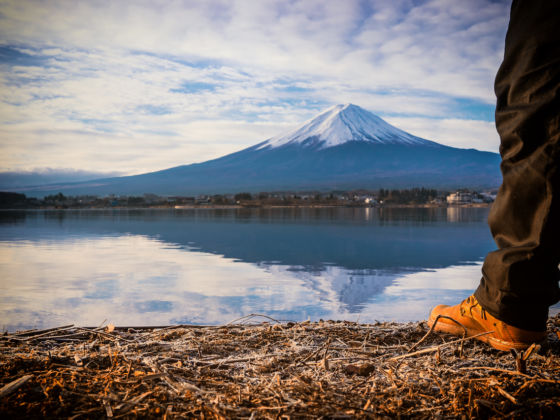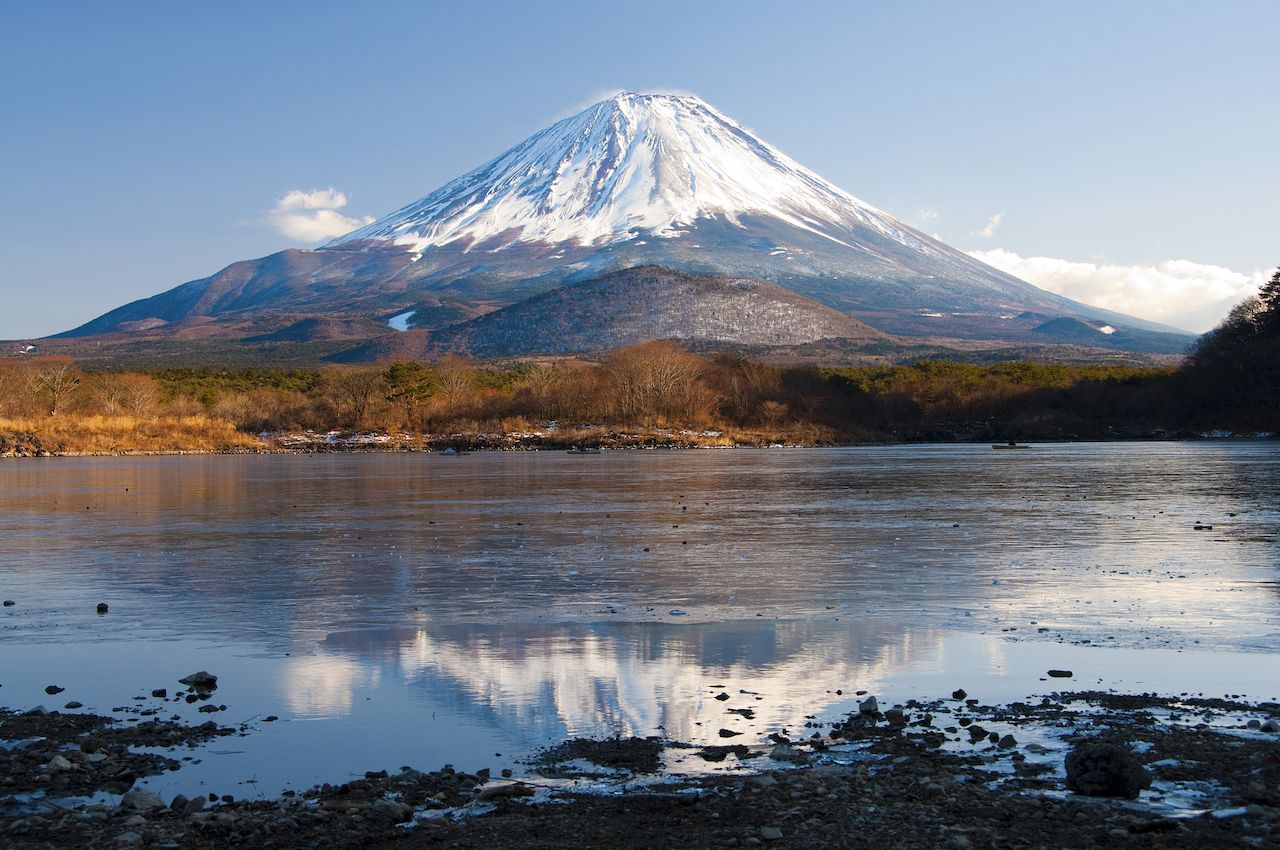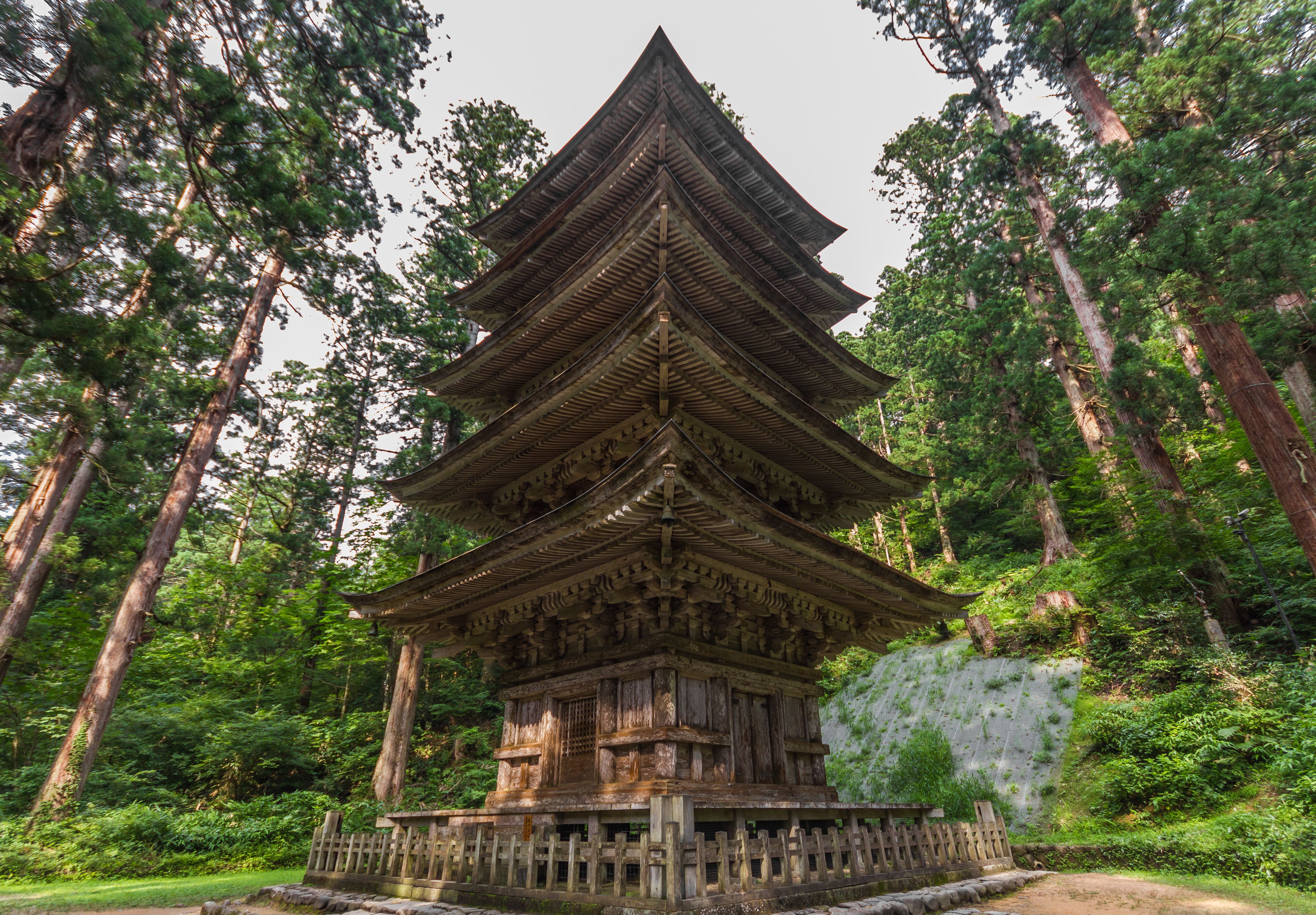Over 70 percent of the Japanese landmass is mountainous. That’s a lot of potential peaks to summit. But traditionally, hiking in Japan was viewed through a different lens. It was a deeply spiritual endeavor: A mountain was not a physical challenge to be conquered, it represented a symbolic struggle to the top. Since time immemorial the dominant religions in Japan have been Shintoism and Buddhism. Baked into the philosophical core of those religions are elements of asceticism and a reverence for nature. Over time, this led to the proliferation of hiking as a ritualistic practice in ancient Japan, and the remnants of this spiritual era still exist on the nation’s mountains today. Here are five of the best spiritual mountain hikes you’ll find in the country.

The Best Spiritual Mountain Hikes in Japan
1. Mount Fuji

Photo: Krishna.Wu/Shutterstock
“He who climbs Mount Fuji is a wise man; he who climbs twice is a fool.” — Ancient Japanese proverb
Mount Fuji, an indelible symbol of the nation, has been revered in Japan as long as recorded history can account for. Locals refer to it as Fuji-san, using a nominal suffix typically employed as a sign of utmost respect. The cone stratovolcano rises 3,776 meters into the heavens, towering above the surrounding range; it looks almost manufactured. One can only begin to imagine the feelings it evoked in the days prior to scientific inquiry.
Mount Fuji has been a sacred site of Japan’s indigenous Shinto religion since the seventh century (and most likely considerably earlier). Princess Konohanasakuya, a Shinto deity symbolized by the Japanese cherry blossom, has a series of ancient shrines dedicated to her along the mountain’s abundant walking trails.
Though it stands as the tallest mountain in the country — and in spite of the foreboding proverb — Fuji is surprisingly accessible to hikers of all levels of ability. During climbing season (July and August), families with small children and elderly folk approaching the autumn of their years can be seen attempting the ascent, snapping photos on rocky cliffs and mulling over hot miso soup in the station huts. At the summit, people pay their respects at the highest shrine in the country, a structure of red-painted wood enclosed by hulking, rain-battered walls of basalt.
For the ultimate experience, you can hike the mountain overnight and watch the dawn break from the highest point in the land of the rising sun. It is no doubt one of the finest scenes in Japan’s natural cinematic repertoire.
2. Mount Mitoku

Photo: IZZARD/Shutterstock
Mount Mitoku, located in the least populous of Japan’s 47 prefectures, Tottori, is famed for the temple hanging precariously from the rock wall at its peak. The temple, Nageiredo, has been bestowed with the title of “Japan’s Most Dangerous National Treasure.”
Japan’s landscape is sprinkled with some of the world’s most ornate and antiquated wooden buildings; Nageiredo, with its roof of sloping cypress, balancing on stilts constructed into the inaccessible cliff-face, is certainly one of them. Local folklore suggests the priest, En no Gyoja, launched the temple up there to its height of 900 meters all on his lonesome, some 1,000 years ago. Whatever possessed him to do such a thing, is not altogether obvious.
The entrance to Mitoku’s spiritual trail is marked by a man-made torii (gate) built into a natural gate of trees. They operate as a symbolic doorway between the artificial and natural worlds. Once you enter the world of Mitoku, you are taking part in an old Buddhist purification ritual called rokkon shojo, where you cleanse your six roots of perception. Said cleansing is complete upon reaching Nageiredo.
3. Mount Haku

Photo: Takahiro Mitsui/Shutterstock
Mount Haku, rising above the confluence of three prefectures — Fukui, Gifu, and Ishikawa — is one of the three sacred mountains of Japan. The current conventional wisdom puts the origin of mountain-climbing worship in the year 717 when a Buddhist priest named Taicho climbed Mount Haku as an ascetic ritual. So in many people’s estimations, it is the home of spiritual hiking in Japan.
The century following Taicho’s historical pilgrimage, Mount Haku was designated three worship trails, while some spectacular temples and shrines were erected along the ascent. Many still remain, including Shirayama Hime; a solemn-looking shrine lying in a wooded cove atop an old stone staircase, with two sculpted lions operating as spiritual guardians. In spite of its brooding appearance, the temple is said to grant good fortune to those who pay a visit.
At just over 2,700 meters Haku is challenging, yet certainly climbable. The trails meander through a national park, passing by alpine flora, volcanic lakes, and plateaus of melting snow. Virgin beech trees envelop much of the mountain, harboring a menagerie of wildlife from raptorial birds to Japanese serows and macaques. Upon reaching the summit you are greeted by a small Shinto monument and panoramic views of the surrounding park.
4. Mount Tate

Photo: le_shile/Shutterstock
Mount Tate, also called Tateyama, is known as “The Roof of Japan.” It joined Fuji and Haku as one of Japan’s three sacred mountains some time between the 17th and 19th centuries. It is home to the famous Tateyama Kurobe Alpine Route linking Nagano and Toyama prefectures.
Mount Tate’s peak, just creeping over 3,000 meters high, looks down upon a geothermally active region where volcanic vents in the earth’s surface billow steam into the atmosphere. This hostile appearance has earned it the nickname, Hell’s Valley. A god is said to reside at the summit, and on completion of the climb, you can join him looking down on the depths of hell. This ascension to Tate’s peak is supposed to guarantee your soul a pass into a heavenly realm after death.
The most popular hiking route is the Kurobe Alpine Route, a long and undulating trail that guides you through shifting and dynamic scenery. Summer offers the most agreeable hiking weather, and in spring, you can trek through the route’s unique alpine snow walls, but fall may be the best time of all when rusty autumnal hues sweep across the rolling profile of the mountain.
5. The Three Mountains of Dewa

Photo: Manuel Ascanio/Shutterstock
The Three Mountains of Dewa are a trifecta of peaks in Yamagata Prefecture, each with a shrine on (or near) its pinnacle. Dewa is one of the homes of Shugendo, an archaic — and often decried — folk religion that fuses elements of Buddhism, Taoism, and Shintoism.
The mountains are: Yudono-san, the most spiritually revered; Haguro-san, the most accessible year-round; and Gas-san, the highest peak at 1,984 meters above sea level. Haguro-san and Gas-san have wooden temples at their summits, symbolizing birth and death respectively. Yudono-san’s temple, however, is so covert in its nature, that its symbolic meaning is not to be spoken of beyond the confines of the temple precinct.
Haguro-san can be summited any time of year, but mid-summer through early autumn is the ideal hiking season for all three peaks. The surrounding Yamagata landscape of dense cedar forests and river valleys is dissected by tumbling streams and stony footpaths. Intricate iconography and sculptures mark routes to the top, while toriis indicate approaching temples. This is what Japanese hiking is all about.